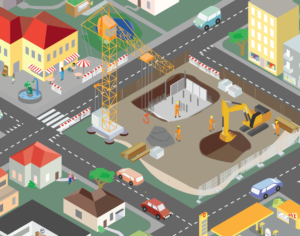The growth in urban population and economic upturn is leading to higher demand for construction, repair and renovation works in cities. Houses, public utilities, retail spaces, offices and infrastructure need to adapt to cope with the increasing number of residents and visitors, urban functions and changing standards.
Construction projects contribute to more attractive, sustainable and economically viable urban areas once they are finished. However, transport activities related to construction works have negative impacts on the surrounding community if not handled appropriately. It is estimated that 15 to 20 percent of heavy goods vehicles in cities are related to construction, and 30 to 40 percent of light commercial vans.
CIVIC project
In the cities studied in the European CIVIC project, construction-related transport was found to be one of the biggest challenges to improving sustainability. Smarter, cleaner and safer construction logistics solutions in urban areas are needed for environmental, societal and economic reasons. However, in many European cities and metropolitan areas the sense of urgency is not evident or a lack of knowledge is creating passivity.
The goal of the CIVIC project is to facilitate and support efficient, sustainable and broadly endorsed transport to, from and around urban construction sites that minimises disruption in the surrounding community, improves construction productivity and optimises energy efficiency. The CIVIC project found that the impact of construction works on mobility and livability of a city was only a very limited part of the urban planning in the cities studied: Amsterdam, Vienna, Brussels, Stockholm and Gothenburg. The studied cities focused on large-scale infrastructure projects such as building motorways, railway stations and underground train systems or development projects, for example, whole new city areas.
It is not only these large projects that need to be considered focusing on the impact of construction-related transports. Additionally, there are many small-scale development projects in cities with a combination of different official and private actors. Contractors and developers/clients are displaying increasing interest in construction logistics since research shows that improved construction logistics can improve the productivity of a construction project by about 30 percent.
Construction companies using innovative logistics concepts see less congestion around the sites and improved productivity and road safety. Thus, there is a need to align public planning coordinating construction projects with traffic planning in order to manage city infrastructure bottlenecks. The ultimate goal is coordinated planning between the public partner of construction projects and the private construction contractors and developers on the necessary measures for mobility, livability and road safety in the city.
CIVIC handbook
The CIVIC handbook has been developed for local governments, clients, developers, contractors, or any other actor that can influence logistics planning and the setup of construction projects. It can help local governments collaborating with private partners to realise more sustainable, and safer, construction works with less inconvenience and cleaner air. In addition, it can help clients, developers and contractors to ensure smooth and efficient construction operations. Hence, sustainable construction logistics could be a future deal-breaker.
Smart governance
The handbook first provides a description of the challenges of urban construction logistics and the governance of construction logistics. Secondly, it presents the smart governance concept developed under the CIVIC project, combining different tools to improve construction logistics and its governance. This concept can be applied on two levels: the city level and the project level.
On a city level, a sense of shared ownership and urgency should be created to optimise construction logistics on the project level. This is the first step of the concept. Steps 2 to 6 outline different tools and methods for the development of a solution: in step 2, a conceptual solution is required to create a common understanding of the prerequisites for the specific project and possible methods for organising logistics. Step 3 entails the different instruments, policies and guidelines that are needed for creating the formal conditions for the solution. In step 4, the specific stakeholders are involved to identify important criteria that influence the selection of the final solution. Step 5 then aims to select the final solution by providing cost calculations and traffic optimisation models. Step 6 entails the collection of data and follow-ups of KPIs. The final step 7 regards the evaluation of the different projects that feedback into the continuous development process of the optimization of construction logistics at a city level. This final step is presented together with step 1 since these both concern the city level.
The Smart Governance Concept should be part of development/construction projects from the very beginning, meaning from the planning phase.
Source: CIVIC project handbook

